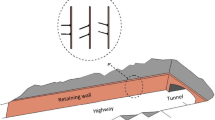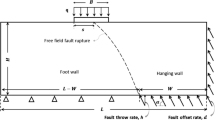Abstract
Slope failure is one of the major recurring geological hazards along the road that connects Woliso town to Wonchi Lake, Central Ethiopia. As a result, this road was repeatedly blocked by failed rock blocks that delay traffic activities and cause casualties. Thus, this study was aimed at identifying and modeling critical rock slope sections along this road by using the Kinematic and Limit Equilibrium Method (LEM). Parameters such as discontinuity and slope geometry factors, unit weight of rocks, and shear strength parameters of failure planes were used for the modeling. The discontinuity and slope geometry factors were determined via a detailed field survey while the unit weight of rocks was determined in the laboratory using a buoyancy technique. The shear strength parameters of failure planes were determined using Rocscience software. The kinematic and LEM modeling were then done on three critical slope sections (RSS1, RSS2, and RSS3) that were identified during the field survey. The Kinematic modeling revealed that slope section RSS1 is subjected to planar failures whilst slope sections RSS2 and RSS3 are exposed to wedge failures. The LEM modeling in terms of Factor of Safety (FOS) revealed that planar failures identified at RSS1 are unstable under all anticipated conditions with a FOS of less than 1. This modeling has also shown that the wedge of RSS2 is only unstable during saturated conditions illustrating a significant contribution of saturation on slope failure. Moreover, the LEM modeling results also displayed that the wedge of RSS3 which is formed due to the intersection of JS1 and JS3 is also unstable under all projected conditions. In general, from the modeling results, saturation, steep slope cuts, and low shear strength parameters of failure planes are identified as the main factors causing slope instability in the study area. This study has designed rock bolts and shotcrete to stabilize unstable rock blocks of critical slope sections. Moreover, surface and subsurface drainage systems are also recommended for better control of the effects of saturation.












Similar content being viewed by others
Data availability
All relevant data are included in the paper or its supplementary information.
References
Abebe B, Dramis F, Fubelli G, Umar M, Asrat A (2010) Landslides in the Ethiopian highlands and the rift margins. Afri Earth Sci 56:131–138
Abramson LW, Lee TS, Sharma S, Boyce GM (2002) Slope stability and stabilization methods. Wiley, New York
Alemu T, Besshawered E, Ayalew A, Zewede T, Yohannes G, Bekele H, Kasahun T (2010) Geological Map of Akaki Beseka area. Geological Survey of Ethiopia, USA
Aleotti P, Chowdhury R (1999) Landslide hazard assessment: summary review and new perspectives. Bull Eng Geol Environ 58:21–44. https://doi.org/10.1007/s100640050066
Alzo’ubi AK, (2016) Rock slopes processes and recommended methods for analysis. Int J Geomate 11(25):2520–2527
Anbalagan R (1992) Landslide hazard evaluation and zonation mapping in mountainous terrain. Eng Geol 32:269–277
ASTM C 805 (2018) Standard Test Method for Rebound Number of Hardened Concrete. ASTM International, West Conshohocken, PA, 2018. www.astm.org
Ayalew L (1999) The effect of seasonal rainfall on landslides in the highlands Of Ethiopia. Bull Eng Geol Env 58(1):9–19
Ayalew L, Yamagishi H, Ugawa N (2004) Landslide susceptibility mapping using GISbased weighted linear combination, the case in the Tsugawa area of Agano River, Niigata Prefecture, Japan. Landslides 1:73–81
Aydin A, Basu A (2005) The Schmidt hammer in rock material characterization. Eng Geol 81(1):1–14. https://doi.org/10.1016/j.enggeo.2005.06.006
Bar N, Yacoub TE, McQuillan A (2019) Analysis of a large open pit mine in Western Australia using finite element and limit equilibrium methods. 53rd US Rock Mech Symp
Barton NR (1976) The shear strength of rock and rock joints. Int J Mech Min Sci Geomech Abstr. 13(10):1–24
Barton N, Choubey V (1977) The shear strength of rock joints in theory and practice. Rock Mecha Felsmech MCaniq Des Roch 10(1–2):1–54. https://doi.org/10.1007/bf01261801
Barton N, Bandis S (1990) Review of predictive capabilities of JRC-JCS model in engineering practice. In: Balkema, AA, (Eds), Proceedings of International Conference on Rock Joints, Leon, Norway
Bekele A, Meten M (2022) Modeling rock slope stability using kinematic, limit equilibrium, and finite-element methods along Mertule Maryam–mekane-selam road. Mod Earth Syst Environm, Central Ethiopia. https://doi.org/10.1007/s40808-022-01563-8
Bell FG (2007) Engineering Geology. In: Bell FG (ed) Butterworth-Heinemann (Elsevier) Burlington. MA
Bieniawski ZT (1989) Engineering Rock Mass Classifications. Wiley, New York, p 251
Bommer J, Rodrı́guez C, (2002) Earthquake-induced landslides in central america. Eng Geol 63(3–4):189–220. https://doi.org/10.1016/s0013-7952(01)00081-3
Bushira KM, Gebregiorgis YB, Verma RK, Sheng Z (2018) Cut soil slope stability analysis along national highway at wozeka-gidole road. Ethio Model Earth Syst Environm 4(2):591–600. https://doi.org/10.1007/s40808-018-0465-6
Chowdhury R, Flentje P, Bhattacharya G (2009) Geotechnical slope analysis. CRC Press
Dahal RK, Hasegawa S, Masuda T, Yamanaka M (2006) Roadside Slope Failures in Nepal during Torrential Rainfall and their Mitigation. Disaster Mitigation of Debris Flows, Slope Failures and Landslides
Duncan JM (2000) Factors of Safety and Reliability in Geotechnical Engineering. J Geotech Geoenvironm Eng ASCE 126(4):307–316
Ermias B, Raghuvanshi TK, Abebe B (2017) Landslide Hazard Zonation (LHZ) around Alemketema Town, North Showa Zone, Central Ethiopia - A GIS-based expert evaluation approach. Int Jr Earth Sci & Engg 10(1):33–44
Girma F, Raghuvanshi TK, Ayenew T, Hailemariam T (2015) Landslide hazard zonation in Ada Berga District, Central Ethiopia –J. Geomatics 90:25–38
Goodman RE (1989) Introduction to rock mechanics, vol 2. Wiley, New York
Hack R (2002) An evaluation of slope stability classification. Proc. Portugal, Madeira, Funchal,. Eds: C. Dinis da Gama & L. Ribeira e Sousa, Publ. Sociedade Portuguesa de Geotecnia, Av. do Brasil, Lisboa, Portugal.
Hamza T, Raghuvanshi TK (2017) GIS-based landslide hazard evaluation and zonation a case from jeldu district, central Ethiopia. J King Saud Univer Sci. 29(2):151–165
Hocking G (1976) A method for distinguishing between single and double-plane sliding of tetrahedral wedges. Int J Rock Mech Min Sci Geomech Abstr 13:225–226
Hoek E, Bray JW (1981) Rock Slope Engineering. Revised 3rd Edition, The Institute of Mining and Metallurgy, London.
Hudson JA, Harrison JP (1997) Engineering rock mechanics. Pergamon, London
ISRM (1978) International Society of Rock Mechanics Suggested Methods for Determining Tensile Strength of Rock Materials. Int J Rock Mech Min Sci 15(3):99–103
Jing L (2003) A review of techniques, advances, and outstanding issues in numerical modeling for rock mechanics and rock engineering. Int J Rock Mech Min Sci. https://doi.org/10.1016/S1365-1609(03)00013-3
Johnson RB, Degraff JV (1991) Principles of Engineering Geology. John Wiley and Sons, New York, p 497
Keefer D (2000) Statistical analysis of an earthquake-induced landslide distribution — the 1989 Loma Prieta. Calif Event Eng Geol 58(3–4):231–249. https://doi.org/10.1016/s0013-7952(00)00037-5
Lamessa G, Meten M (2021) Stability Analysis of rock slope along selected road sections from Gutane Migiru town to Fincha Sugar Factory. SN Applied Sciences, Oromiya, Ethiopia. https://doi.org/10.1007/s42452-020-04026-w
Lisle RJ (2004) Calculation of the daylight envelope for the plane failure of rock slopes. Geotechnique 54(4):279–280
Mebrahtu TK, Heinze T, Wohnlich S, Alber M (2022) Slope stability analysis of deep-seated landslides using limit equilibrium and finite element methods in Debre Sina area. Bullet Eng Geol Environm, Ethiopia. https://doi.org/10.1007/s10064-022-02906-6
Pantelidis L (2009) Rock slope stability assessment through rock mass classification systems. Int J Rock Mech Min Sci 46(2):315–325
Park H, West T (2001) Development of a probabilistic approach for rock wedge failure. Eng Geol 59:233–251
Raghuvanshi TK (2017) Plane failure in rock slopes–A review on stability analysis techniques. J King Saud Univer Sci. 23:767
Raghuvanshi T, Ibrahim J, Ayalew D (2014) Slope stability susceptibility evaluation parameter (SSEP) rating scheme – An approach for landslide hazard zonation. J Afr Earth Sc 99:595–612. https://doi.org/10.1016/j.jafrearsci.2014.05.004
Rawat V (2019) Efficiency of shear wall location on reinforced concrete buildings in ethiopia under seismic excitation. Int J Rec Technol Eng (IJRTE) 8(4):10624–10631. https://doi.org/10.35940/ijrte.d4252.118419
Rocscience (2004a) Dips 6.0, http://www.rocscience.com/softw are/dips.
Rocscience (2004b) Rocdata 3.0, http://www.rocscience.com/software/rocdata
Rocscience (2004c) RocPlane 2.0, http://www.rocscience.com/software/rocplane
Rocscience (2004d) Swedge 4.0 http://www.rocscience.com/software/swedge
Romana M (1985) New adjustment ratings for application of Bieniawski classification to the slope. In: Int. Sym. Role Rock Mech., Zacatecas,
Sharma S, Raghuvanshi T, Sahai A (1999) An engineering geological appraisal of the Lakhwar dam, Garhwal Himalaya. India Eng Geol 53(3–4):381–398
Song D, Chen Z, Ke Y, Nie W (2020) Seismic response analysis of a bedding rock slope based on the time-frequency joint analysis method: a case study from the middle reaches of the Jinsha River. China Eng Geol 274:105731
Tang H, Yong R, EzEldin MAM (2016) Stability analysis of stratified rock slopes with spatially variable strength parameters: the case of Qianjiangping landslide. Bull Eng Geol Environ 76:839–853. https://doi.org/10.1007/s10064-016-0876-4
Temesgen B, Mohammed U, Korme T (2001) Natural hazard assessment using gis and remote sensing methods, with particular reference to the landslides in the wondogenet area. Solar Terrest Planet Sci 26(9):665–615
Turrini CT, Visintainer P (1998) Proposal of a method to define areas of landslide hazard and application to an area of the Dolomites. Italy Eng Geol 50:255–265
Ulusay R, Karakul H (2015) Assessment of basic friction angles of various rock types from Turkey under dry, wet, and submerged conditions and some considerations on tilt testing. Bullet Eng Geol Environm 75(4):1683–1699. https://doi.org/10.1007/s10064-015-0828-4
Wang X, Niu R (2009) Spatial forecast of landslides in three gorges based on spatial data mining. Sensors 9(3):2035–2061. https://doi.org/10.3390/s90302035
Woldearegay K (2013) Review of the occurrences and influencing factors of landslides in the highlands of Ethiopia: With implications for infrastructural development. Momona Ethiop J Sci 5(1):3–31
Wyllie DC, Mah CW (2004) Rock Slope Engineering 4thEd. The Institution of Mining and Metallurgy, London
Wyllie DC, Norrish N (1996) Landslides: Investigation And Mitigation. Transport Res Board. 11:474–504
Acknowledgements
The authors express their sincere thanks to Oromia Water Works and Design Supervision Enterprise for allowing laboratory testing. The first author also extends her Special thanks to Adama Science and Technology University for the financial support.
Author information
Authors and Affiliations
Corresponding author
Ethics declarations
Conflict of interest
The authors declare that they have no conflicts of interest.
Additional information
Publisher's Note
Springer Nature remains neutral with regard to jurisdictional claims in published maps and institutional affiliations.
Rights and permissions
Springer Nature or its licensor (e.g. a society or other partner) holds exclusive rights to this article under a publishing agreement with the author(s) or other rightsholder(s); author self-archiving of the accepted manuscript version of this article is solely governed by the terms of such publishing agreement and applicable law.
About this article
Cite this article
Tesfaye, M., Regassa, B. & Garo, T. Rock slope stability modeling using kinematic and limit equilibrium methods along Woliso to Wonchi lake road, central Ethiopia. Model. Earth Syst. Environ. 10, 331–347 (2024). https://doi.org/10.1007/s40808-023-01780-9
Received:
Accepted:
Published:
Issue Date:
DOI: https://doi.org/10.1007/s40808-023-01780-9




